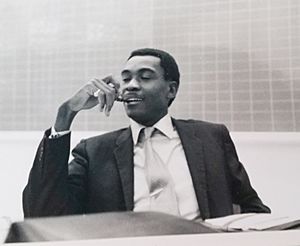1980 Miami riots facts for kids
Quick facts for kids 1980 Miami riots |
|||
|---|---|---|---|
| Part of Race riots in Miami | |||
| Date | May 17, 1980 – May 20, 1980 | ||
| Location | |||
| Caused by | acquittal of officers who beat Arthur McDuffie to death | ||
| Parties to the civil conflict | |||
|
|||
| Lead figures | |||
|
|||
| Casualties | |||
| Death(s) | 18 | ||
| Injuries | 350 | ||
| Arrested | 600 | ||
The 1980 Miami riots were a series of public disturbances that took place in Miami, Florida. They began on May 17, 1980, after a jury found four police officers not guilty in the death of Arthur McDuffie. McDuffie was a Black insurance salesman and former United States Marine Corps lance corporal. He died from injuries after being stopped by police.
The riots mainly happened in Black neighborhoods like Overtown and Liberty City. They lasted until May 20, causing at least 18 deaths. Property damage was estimated at $100 million. In 1981, McDuffie's family received $1.1 million in a legal settlement. These riots were the deadliest in the U.S. since the 1960s. They remained so until the 1992 Los Angeles riots twelve years later.
Contents
What Led to the Riots?
The Death of Arthur McDuffie
In the early morning of December 17, 1979, six police officers stopped Arthur McDuffie. He was 33 years old and riding his motorcycle. McDuffie had a suspended driver's license and had received many traffic tickets. Police reports said he led officers on a high-speed chase.
The officers claimed McDuffie lost control of his motorcycle. They said he hit his head and then tried to run away. The officers caught him, and a struggle followed. Police later drove a patrol car over the motorcycle. This was done to make the incident look like a motorcycle accident.
McDuffie was taken to a hospital. He died four days later from his injuries. The medical examiner, Dr. Ronald Wright, said McDuffie's injuries were very severe. They did not match what would happen in a motorcycle crash. Dr. Wright believed McDuffie was a victim of police brutality.
The Court Case
The head of the Public Safety Department, Bobby Jones, suspended three officers. On December 28, several officers were accused of serious crimes. These included causing McDuffie's death and hiding evidence. Other officers were also suspended.
Because of strong feelings in Miami, the trial was moved to Tampa. Jury selection started on March 31, 1980. The main prosecutor was Janet Reno. She later became the U.S. Attorney General.
The defense lawyers argued that McDuffie attacked the police. They said he was an ex-Marine and a karate expert. They claimed the officers used only the force needed to control him.
On May 17, the jury made its decision. The jury was made up of six White men. After less than three hours, they found the remaining officers not guilty on all charges. This decision was a major cause of the riots that followed.
The Riots Begin
The jury's decision on May 17 caused immediate protests in Miami. About 5,000 people gathered at the Metro Justice Building. By 6:00 p.m. that night, the protest had turned into a riot.
Florida Governor Bob Graham sent 500 National Guard troops to the area. He doubled their number the next day, but the riots continued. Twelve more people died, and 165 were hurt. Violence spread to areas like Black Grove, Overtown, Liberty City, and Brownsville.
By the third day, the violence started to decrease. The city set a curfew from 8:00 p.m. to 6:00 a.m. They also temporarily stopped the sale of guns and alcohol. Governor Graham sent in 2,500 more National Guardsmen. This brought the total to 3,500 troops.
Local police blocked off parts of Coconut Grove. This was to keep drivers away, as people were throwing rocks at cars. The city came to a stop. Reports of snipers shooting at drivers on freeways also stopped traffic. The military had to step in to restore order.
In total, 18 people died during the three days of rioting. About 370 people were injured, including children. Over 780 people were arrested. Property damage was more than $100 million.
What Happened After?
The federal government declared Miami a disaster area. This allowed the city to receive money to help rebuild. The Miami police union threatened a strike if the officers were not given their jobs back. The next day, the five officers who were found not guilty were reinstated.
Federal Civil Rights Trial
Soon after the first trial, the U.S. Justice Department decided to investigate. They looked into whether the police officers had violated federal civil rights laws. On July 28, 1980, a federal grand jury accused Charles Veverka. This was despite him having received immunity in the first state trial.
The federal trial was moved to San Antonio, Texas. It had been moved from Miami to Atlanta, then to New Orleans. Each city asked for it to be moved because of its sensitive racial issues. Journalists called it "The Trial That Nobody Wants."
On December 17, Veverka was found not guilty after a week-long trial. The jury took over 16 hours to decide. The jury foreman said Veverka's own statement, which went against the initial police reports, was a big reason for the decision. Minor incidents of violence were reported in Miami after the verdict.
Legal Settlement
On November 17, 1981, Dade County officials agreed to a $1.1 million settlement. This was paid to McDuffie's family. In return, the family dropped their $25 million lawsuit against the county. A large part of this money went to the family's legal team. McDuffie's two children and his mother also received money from the settlement.


